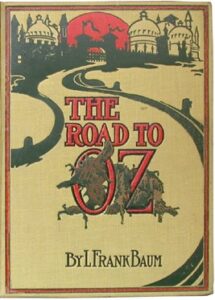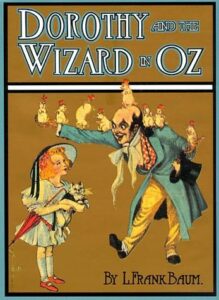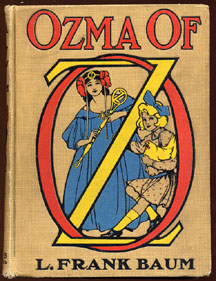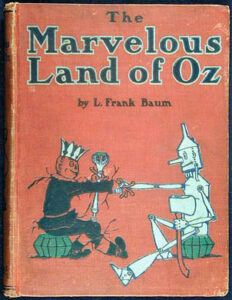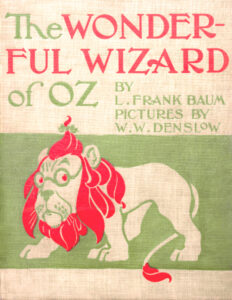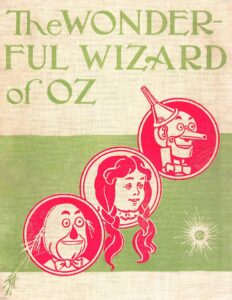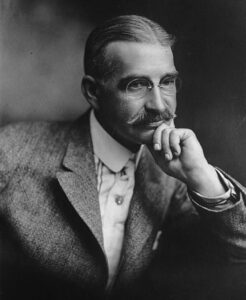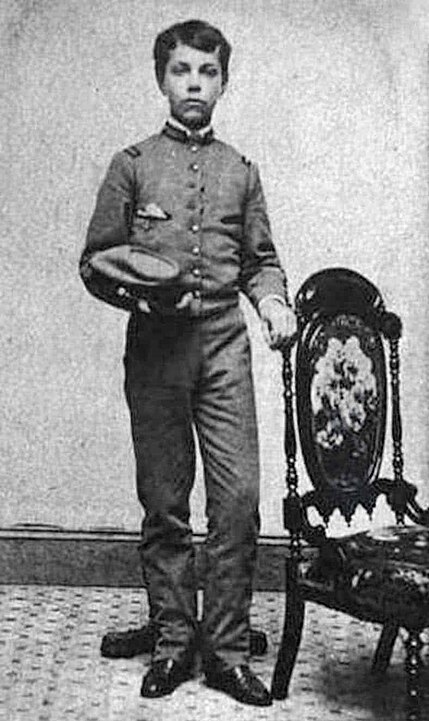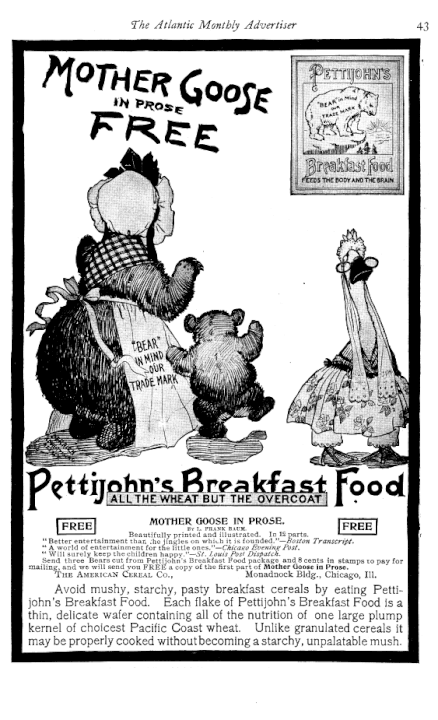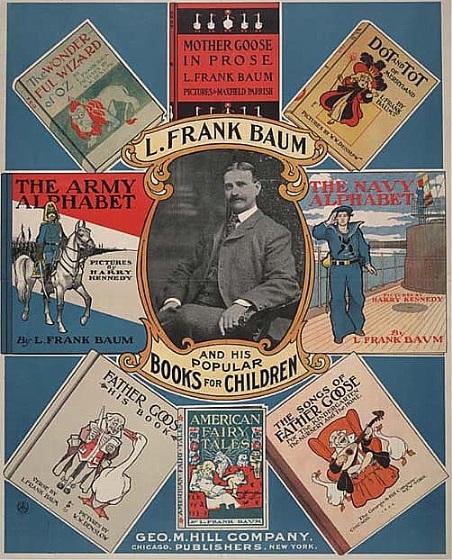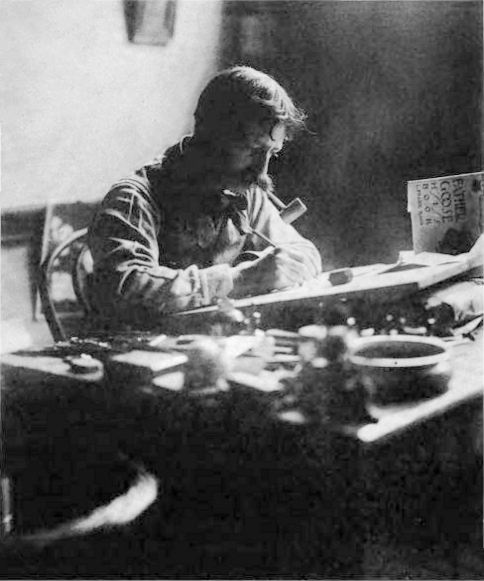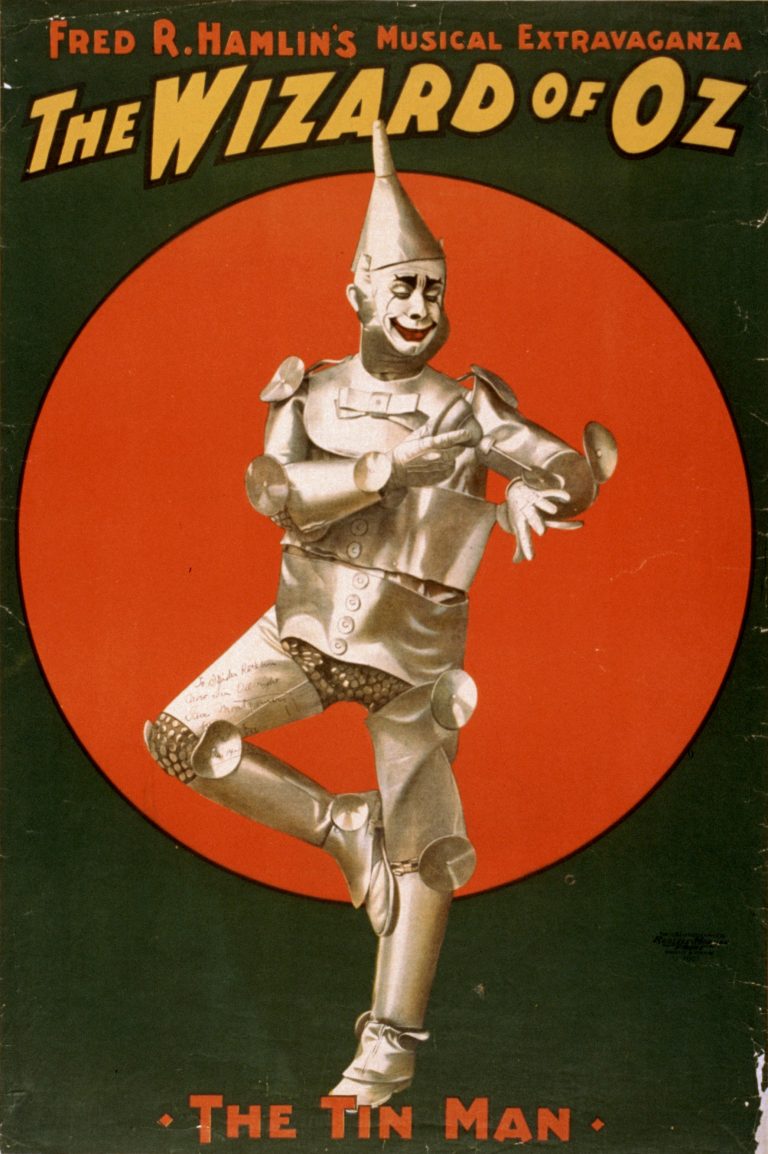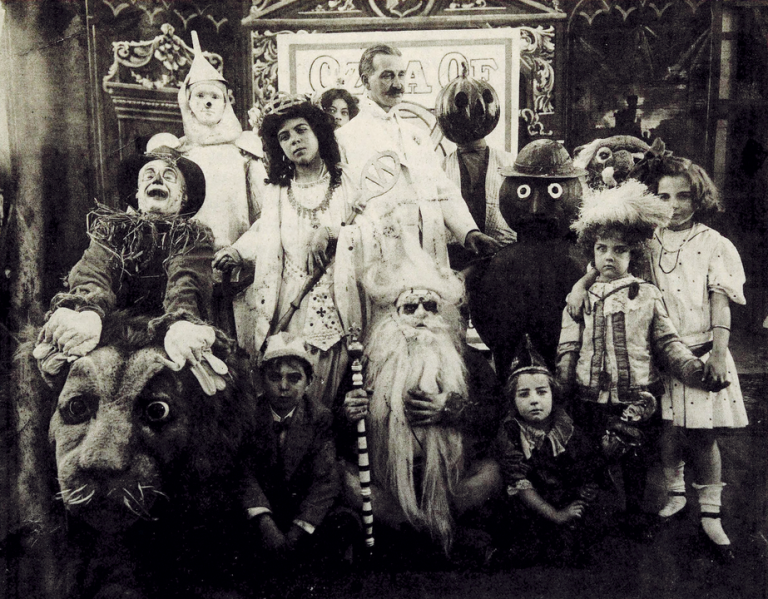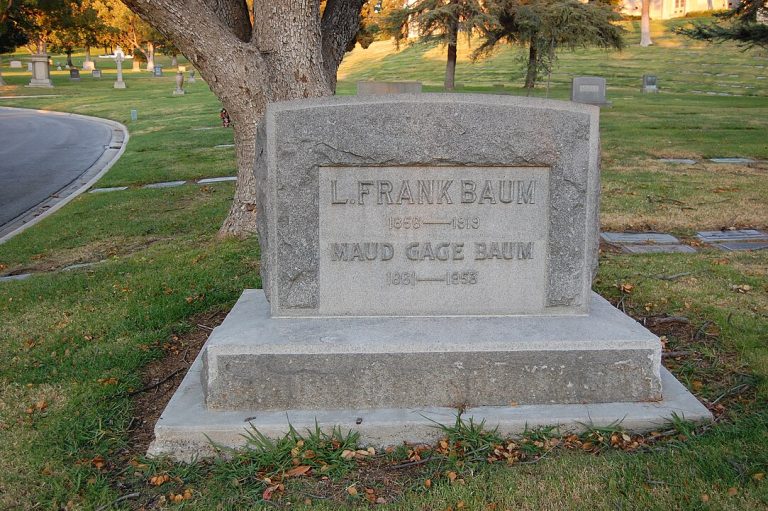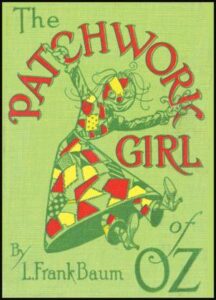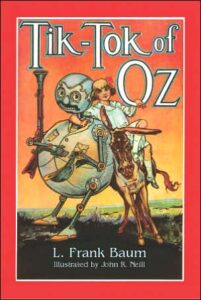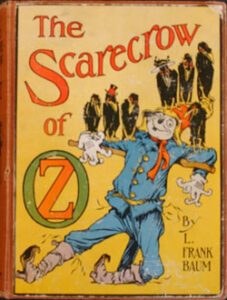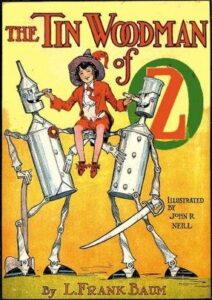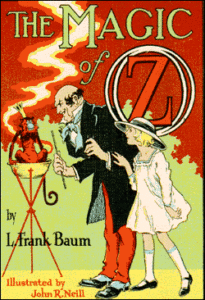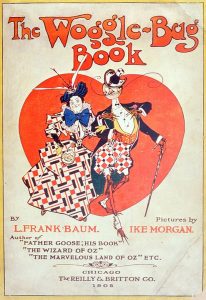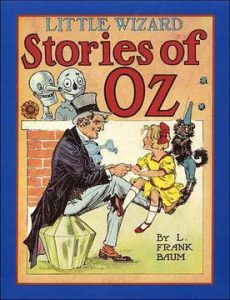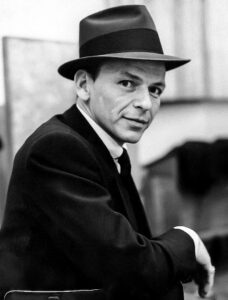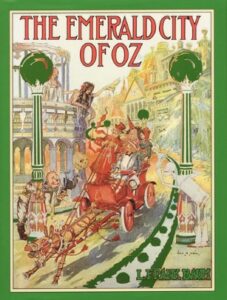
You can download this book and the thirteen other fantasy books in the Oz series by L. Frank Baum via Project Gutenberg by clicking here.
About The Emerald City Of Oz
The Emerald City of Oz is the sixth of L. Frank Baum’s fourteen Land of Oz books. It was also adapted into a Canadian animated film in 1987. Originally published on July 20, 1910, it is the story of Dorothy Gale and her Uncle Henry and Aunt Em coming to live in Oz permanently. While they are toured through the Quadling Country, the Nome King is assembling allies for an invasion of Oz. This is the first time in the Oz series that Baum made use of double plots for one of the books.
Baum had intended to cease writing Oz stories with this book, but financial pressures prompted him to write and publish The Patchwork Girl of Oz, with seven other Oz books to follow.
The book was dedicated to Her Royal Highness Cynthia II of Syracuse — actually the daughter (born in the previous year, 1909) of the author’s younger brother Henry Clay “Harry” Baum.
Commentary
The Emerald City of Oz contains more material on the social organization of Oz than most of the earlier books, and as a consequence has attracted commentary on its Utopian aspects. The explicitly socialist economy of Oz has been contrasted to other fantasy projections of socialist societies, like Edward Bellamy’s Looking Backward (1888) and William Morris’s News from Nowhere (1890). How far such analyses and comparisons should be pursued is, of course, open to debate; as Baum writes of the social structure of Oz in Chapter Three, p. 31, “I do not suppose such an arrangement would be practical with us….” There are also strong similarities between The Emerald City of Oz (and to a certain extent the other Oz books) and the 1915 feminist utopia Herland (novel) by Charlotte Perkins Gilman. Today probably best known for The Yellow Wallpaper, Gilman was, like Baum, a newspaper editor who used her publication as a platform for social reform. The literary connection between Gilman and Baum is thought to be another campaigning newspaper editor, Matilda Joslyn Gage, the women’s rights activist who happened to be the mother of Baum’s wife, Maud Gage Baum. Sally Roesch Wagner of The Matilda Joslyn Gage Foundation published The Wonderful Mother of Oz describing how Matilda Gage’s feminist politics were sympathetically channelled by her son-in-law into his Oz books.
Gregory Maguire, the author of the revisionist Oz novels Wicked and Son of a Witch, has written that The Emerald City of Oz “is suffused with an elegiac quality” and compares its tone with that of The Last Battle, the final volume of C. S. Lewis’ Chronicles of Narnia.
The Forbidden Fountain that Baum introduces in this book recurs in ensuing Oz books, by him and by his various successors. The Fountain is an important feature in The Magic of Oz (1919), The Forbidden Fountain of Oz (1980), The Wicked Witch of Oz (1993), and Paradox in Oz (1999).
The Plot
SPOILER ALERT: Skip this bit if you haven’t read the book and are planning to do so!
At the beginning of this story, it is made quite clear that Dorothy Gale (the primary protagonist of many of the previous Oz books), is in the habit of freely speaking of her many adventures in the Land of Oz to her only living relatives, her Aunt Em and Uncle Henry. Neither of them believes a word of her stories, but consider her a dreamer, as her dead mother had been. She is undeterred.
Later, it is revealed that the destruction of their farmhouse by the tornado back in The Wonderful Wizard of Oz has left Uncle Henry in terrible debt. In order to pay it, he has taken out a mortgage on his farm. If he cannot repay his creditors, they will seize the farm, thus leaving Henry and his family homeless. He is not too afraid for himself, but both he and his wife, Aunt Em, fear very much for their niece’s future. Upon learning this, Dorothy quickly arranges with Princess Ozma to let her bring her guardians to Oz where they will be happier and forever safe. Using the Magic Belt (a tool captured from the jealous Nome King Roquat), Ozma transports them to her throne room. They are given rooms to live in and luxuries to enjoy, including a vast and complex wardrobe, and meet with many of Dorothy’s old friends, including the Cowardly Lion and Billina the Yellow Hen.
In the underground Nome Kingdom, the Nome King Roquat is plotting to conquer the Land of Oz and recover his magic belt, which Dorothy took from him in Ozma of Oz. General Blug suggested that King Roquat have their forces dig a tunnel under the Deadly Desert. After ordering the expulsion of General Blug (who will not agree to such an attack due to the powers of Princess Ozma) and the death of Colonel (who also refuses) where he was sliced thin in a torture chamber and fed to a bunch of Seven-Headed Dogs, King Roquat holds counsel with a veteran soldier called Guph. Guph believes that against the many magicians of Oz (the reputation of which has grown in the telling), the Nome Army has no chance alone. He, therefore, sets out personally to recruit allies from other parts of Nonestica.
Dorothy, accompanied by the Wizard of Oz and several other friends, departs the Emerald City in a carriage drawn by the Wooden Sawhorse, intending to give her aunt and uncle a tour of the land. Many of the people encountered have never been seen in other books:
The living cut-out paper dolls created by an immortal called Miss Cuttenclip.
The anthropomorphic jigsaw puzzles known as the Fuddles.
The loquacious Rigmaroles.
The paranoid Flutterbudgets.
The living kitchen utensils of Utensia.
The anthropomorphic pastries of Bunbury.
The civilized rabbits of Bunnybury.
A zebra who holds geographical disputes with a soft-shell crab.
Other figures, more familiar to readers of previous books, include the Tin Woodman and the Scarecrow, as well as the four tribes of Oz (the Munchkins, the Quadlings, the Gillikins, and the Winkies).
The Nome General Guph visits three nations:
The Whimsies are a large and hulking race but possess disproportionately small heads the size of doorknobs. This causes other species to call them stupid, stripping them of any self-esteem. To deny this, the Whimsies wear enormous, luridly designed masks that cover all of their heads. Their Chief agrees to the deal and sends Guph on his way. The Chief of the Whimsies hopes that when the Nome King reclaims his Magic Belt, he can use its magic to make their heads the size of the masks they wear.
The Growleywogs are muscular giants, possessing no surplus flesh and no mercy. They are arrogant and cruel. Their Grand Gallipoot agrees to the deal in exchange that they grant them 20,000 slaves from the Land of Oz. As such, they are eager not only to help the Nomes conquer Oz but also to secretly subjugate the Nomes as well. Of the latter plan, they say nothing and send Guph on his way.
Last of his meetings is that which is with the mysterious, diabolical Phanfasms of Phantastico. To Guph, the Phanfasms resemble hairy men but have the heads of various carnivorous mammals, birds, and reptiles. Their true forms, number, standard of living, culture, and extent of influence remain unknown to both Guph and the reader, although both receive hints in the narrative. The first Phanfasm that Guph encountered was one with the head of an owl after getting past the scarlet alligator on the bridge. Their bear-headed leader called the First and Foremost agrees to the deal so that they can make people unhappy. The Phanfasms tell him that they will conquer Oz alongside the other armies, but they have a secret plan to turn traitor and dominate their allies. Of the latter plan, they say nothing and send Guph on his way.
Having learned of this through Ozma’s omniscient Magic Picture, the people of Oz become worried. As the Nomes dig a tunnel for the combined armies to get under the Deadly Desert to the heart of the Emerald City, Ozma uses her Magic Belt to wish for a large amount of dust to appear in the tunnel. Upon emerging, the Nome King’s allies, therefore, drink thirstily from the nearby Fountain of Oblivion, whose waters make them forget their evil plans. The Nome King himself avoids the drink but is thrown into the fountain by the Scarecrow and the Tin Woodman, which erases his memory too.
Ozma uses the Magic Belt to send the Nome King and his allies back to their respective lands. To forestall a future invasion of Oz, Glinda the Good Witch uses a magic charm to render Oz invisible and unreachable to everyone except those within the land itself.
Read more about The Emerald City Of Oz here.
The above articles were sourced from Wikipedia and are subject to change.
Blog Posts
Books: The Oz Series By L. Frank Baum.
Books: The Wonderful Wizard Of Oz By L. Frank Baum.
Books: The Marvelous Land Of Oz By L. Frank Baum.
Books: Ozma Of Oz By L. Frank Baum.
Books: Dorothy And The Wizard In Oz By L. Frank Baum.
Books: The Road To Oz By L. Frank Baum.
Books: The Patchwork Girl Of Oz By L. Frank Baum.
Books: Tik-Tok Of Oz By L. Frank Baum.
Books: The Scarecrow Of Oz By L. Frank Baum.
Books: Rinkitink In Oz By L. Frank Baum.
Books: The Lost Princess Of Oz By L. Frank Baum.
Books: The Tin Woodman Of Oz By L. Frank Baum.
Books: The Magic Of Oz By L. Frank Baum.
Books: Glinda Of Oz By L. Frank Baum.
Books: Queer Visitors From The Marvelous Land Of Oz By L. Frank Baum.
Books: The Woggle-Bug Book By L. Frank Baum.
Notes And Links
The 1910 first edition front cover image shown at the top of this page is © John R. Neill and is in the Public Domain via Wikipedia.
Project Gutenberg – Project Gutenberg is an online library of free e-books and was the first provider of free electronic books. Michael Hart, the founder of Project Gutenberg, invented e-books in 1971 and his memory continues to inspire the creation of them and related content today.
The Wonderful Wiki of Oz – Official website. A wonderful and welcoming encyclopedia of all things Oz that anyone can edit or contribute Oz-related information and Oz facts to enjoy.
The Oz Archive on Facebook – Archiving and celebrating the legacy of Oz.
The Oz Archive on Twitter – Archiving and celebrating the legacy of Oz.
The Oz Archive on Instagram – Archiving and celebrating the legacy of Oz.
The Oz Archive on TikTok – Archiving and celebrating the legacy of Oz.
